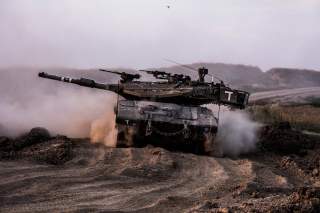Tanks: Obsolete or Every Army's Top Weapon of War
Perhaps one day the development of exoskeletons will give the infantry the Starship Troopers-like capabilities of a tank. In which case, someone will probably develop an armored vehicle more powerful than the infantryman.
It was forty-five years ago that the obituary of the tank was written.
Except that the death notice was premature.
It was October 6 to 8, 1973, when the tank was supposed to have met its demise. Egypt had launched a surprise amphibious assault across the Suez Canal into Israeli-held Sinai. The vaunted tanks of the Israel Defense Force repeated what had worked brilliantly in the 1967 Six-Day War: immediate armored counterattacks, cavalry-like charges that would send the Egyptians fleeing back across the canal.
But the Egyptian infantry didn't flee. It unleashed massed volleys of RPG-7 anti-tank rockets and Sagger wire-guided anti-tank missiles, so many that even surviving Israeli tanks were draped in missile wires. The result was the funeral pyres of hundreds of burning Israeli Patton tanks. Alas, the armored knights had been slain by peasants armed with cheap anti-tank rockets and wire-guided anti-tank missiles.
By October 8, the decimated Israeli forces in Sinai called off their attack. But the questions remained. Had the king of the battlefield been dethroned? If a foot soldier with a rocket launcher could destroy an expensive tank and its highly trained crew, then simple economics suggested that hordes of infantry armed with cheap anti-tank weapons would simply overwhelm a comparatively small number of tanks.
Had the tank become obsolete? Had the infantry—history's Queen of Battle—resumed its dominion?
Yet forty-five years after that fateful Saturday of Yom Kippur, the tank lives. And not just lives, but appears to be thriving. Russia has created a stir with its advanced T-14 Armata tank. But there are also America's M-1 Abrams, Israel's Merkava IV, Britain's Challenger and Germany's Leopard. In fact, the United States is already developing a next-generation armored fighting vehicle.
Why are tanks still around?
The first answer is that the 1973 war was misunderstood. Israel's failure was one of tactics, not technology. Blindly charging the enemy usually hasn't worked well, whether it was the slaughter of French knights as they charged English archers at Agincourt in 1415, or English tanks savaged by Rommel's 88-millimeter anti-tank guns at Gazala in 1942. While the folly of the Israeli armor is remembered as an example of what not to do, less well-known is how quickly Israeli tankers adapted to the new environment. Instead of unsupported tanks rushing at the enemy, Israeli used combined arms tactics where infantry, armor and artillery cooperated.
Combined arms worked for Roman legions and Napoleon's armies, and they restored the tank to the battlefield, albeit as a team player. Two weeks after the IDF's initial defeats, it was the Egyptian armies in Sinai who were encircled.
Another answer is that technology has changed. Modern tanks are being equipped with active protection systems, which detect incoming anti-rocket weapons and then stop them with a barrage of shotgun-like shells. Not surprisingly, the Israelis have pioneered APS technology, which the U.S. Army is evaluating for its own armored vehicles.
Recommended: What Will the Sixth-Generation Jet Fighter Look Like?
Recommended: Imagine a U.S. Air Force That Never Built the B-52 Bomber
Recommended: Russia's Next Big Military Sale - To Mexico?
Recommended: Would China Really Invade Taiwan?
Finally, as I have said more than once, the tank is as much concept as machine. It reflects the fact that technology enables the creation of a mechanical device capable of more firepower, protection and mobility than a foot soldier can carry on his back. The advent of man-portable anti-tank weapons—which date back to World War II bazookas—has evened the odds somewhat, in that the infantry are not helpless against tanks. But ironically, modern infantry goes into battle inside tank-like vehicles like the M2 Bradley and BMP.
Perhaps one day, the development of exoskeletons will give the infantry the Starship Troopers-like capabilities of a tank. In which case, someone will probably develop an armored vehicle more powerful than the infantryman.
Michael Peck is a contributing writer for the National Interest. He can be found on Twitter and Facebook.
Image: Flickr / Israel Defense Forces

